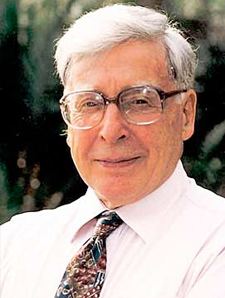Name Robert Edwards Role Physiologist | Died April 10, 2013, England Fields Physiology | |
 | ||
Born Robert Geoffrey Edwards27 September 1925Batley, England ( 1925-09-27 ) Institutions University of CambridgeUniversity of EdinburghBangor UniversityNational Institute for Medical ResearchUniversity of GlasgowCalifornia Institute of TechnologyChurchill College, CambridgeBourn Hall Clinic Alma mater Bangor UniversityUniversity of Edinburgh Thesis The experimental induction of heteroploidy in the mouse (1955) Books Conception in the Human Female Awards Nobel Prize in Physiology or Medicine, Lasker-DeBakey Clinical Medical Research Award | ||
Sir Robert Geoffrey Edwards, (27 September 1925 – 10 April 2013) was an English physiologist and pioneer in reproductive medicine, and in-vitro fertilisation (IVF) in particular. Along with the surgeon Patrick Steptoe, Edwards successfully pioneered conception through IVF, which led to the birth of Louise Brown on 25 July 1978. They founded the first IVF program for infertile patients and trained other scientists in their techniques. Edwards was the founding editor-in-chief of Human Reproduction in 1986. In 2010, Edwards was awarded the Nobel Prize in Physiology or Medicine "for the development of in vitro fertilization".
Contents
- Education and early career
- Career and research
- Human Fertilization
- Honours and awards
- Personal life
- Death
- References
Education and early career
Edwards was born in Batley, Yorkshire, and attended Manchester Central High School on Whitworth Street in central Manchester, after which he served in the British Army, and then completed his undergraduate studies in biology, graduating with an Ordinary degree at Bangor University. He studied at the Institute of Animal Genetics and Embryology at the University of Edinburgh, where he was awarded a PhD in 1955.
Career and research
After a year as a postdoctoral research fellow at the California Institute of Technology he joined the scientific staff of the National Institute for Medical Research at Mill Hill. After a further year at the University of Glasgow, in 1963 he moved to the University of Cambridge as Ford Foundation Research Fellow at the Department of Physiology, and a member of Churchill College, Cambridge. He was appointed Reader in physiology in 1969.
Human Fertilization
Circa 1960 Edwards started to study human fertilisation, and he continued his work at Cambridge, laying the groundwork for his later success. In 1968 he was able to achieve fertilisation of a human egg in the laboratory and started to collaborate with Patrick Steptoe, a gynaecologic surgeon from Oldham. Edwards developed human culture media to allow the fertilisation and early embryo culture, while Steptoe used laparoscopy to recover ovocytes from patients with tubal infertility. Their attempts met significant hostility and opposition, including a refusal of the Medical Research Council to fund their research and a number of lawsuits. Additional historical information on this controversial era in the development of IVF has been published. Roger Gosden was one of his first graduate students.
The birth of Louise Brown, the world's first 'test-tube baby', at 11:47 pm on 25 July 1978 at the Oldham General Hospital made medical history: in vitro fertilisation meant a new way to help infertile couples who formerly had no possibility of having a baby.
Refinements in technology have increased pregnancy rates and it is estimated that in 2010 about 4 million children have been born by IVF, with approximately 170,000 coming from donated oocyte and embryos. Their breakthrough laid the groundwork for further innovations such as intracytoplasmatic sperm injection ICSI, embryo biopsy (PGD), and stem cell research.
Edwards and Steptoe founded the Bourn Hall Clinic as a place to advance their work and train new specialists. Steptoe died in 1988. Edwards continued on in his career as a scientist and an editor of medical journals.
Honours and awards
Edwards received numerous honours and awards including:
Personal life
Edwards married Ruth Fowler Edwards (1930–2013), also a scientist with significant work, granddaughter of 1908 Nobel laureate physicist Ernest Rutherford and daughter of physicist Ralph Fowler, in 1956. The couple had 5 daughters and 12 grandchildren.
Death
Edwards died at home near Cambridge, England on 10 April 2013 after a long lung illness. A spokesperson for the University of Cambridge said "He will be greatly missed by family, friends and colleagues." The Guardian reported that, as of Edwards' death, more than four million births had resulted from IVF. Louise Brown said "His work, along with Patrick Steptoe, has brought happiness and joy to millions of people all over the world by enabling them to have children." According to the BBC, his work was motivated by his belief that "the most important thing in life is having a child."
A plaque was unveiled at the Bourn Hall Clinic in July 2013 by Louise Brown and Alastair MacDonald – the world's first IVF baby boy – commemorating Steptoe and Edwards.
